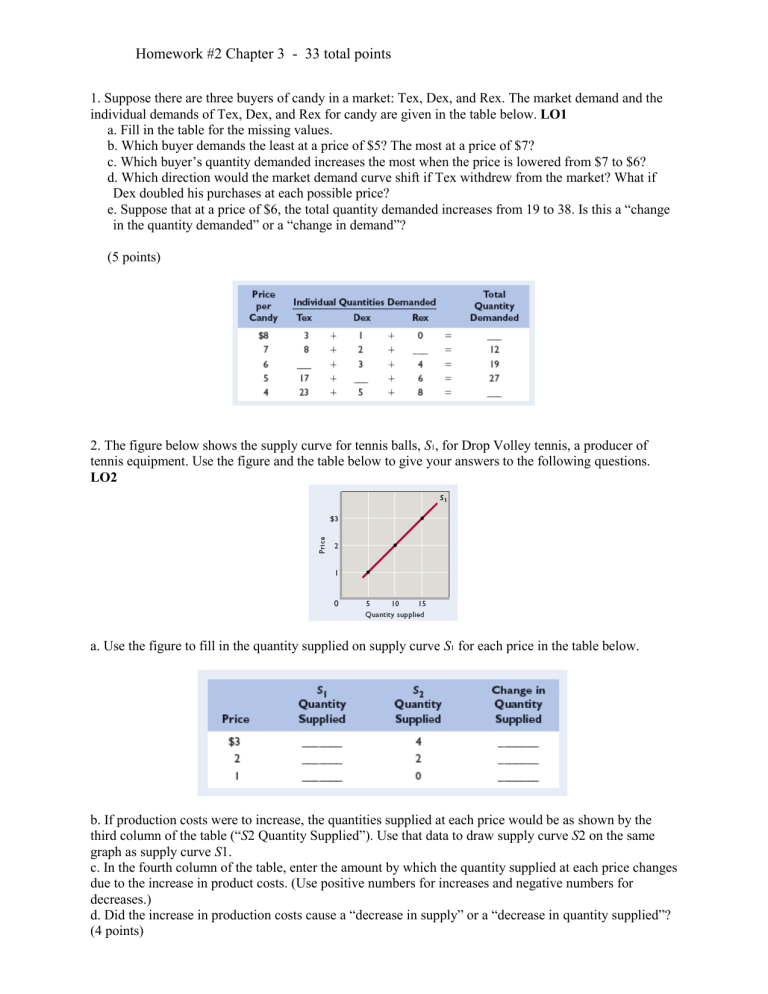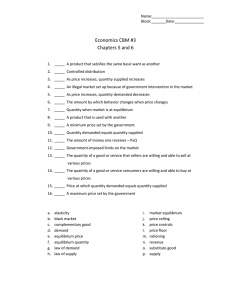
Homework #2 Chapter 3 - 33 total points 1. Suppose there are three buyers of candy in a market: Tex, Dex, and Rex. The market demand and the individual demands of Tex, Dex, and Rex for candy are given in the table below. LO1 a. Fill in the table for the missing values. b. Which buyer demands the least at a price of $5? The most at a price of $7? c. Which buyer’s quantity demanded increases the most when the price is lowered from $7 to $6? d. Which direction would the market demand curve shift if Tex withdrew from the market? What if Dex doubled his purchases at each possible price? e. Suppose that at a price of $6, the total quantity demanded increases from 19 to 38. Is this a “change in the quantity demanded” or a “change in demand”? (5 points) 2. The figure below shows the supply curve for tennis balls, S1, for Drop Volley tennis, a producer of tennis equipment. Use the figure and the table below to give your answers to the following questions. LO2 a. Use the figure to fill in the quantity supplied on supply curve S1 for each price in the table below. b. If production costs were to increase, the quantities supplied at each price would be as shown by the third column of the table (“S2 Quantity Supplied”). Use that data to draw supply curve S2 on the same graph as supply curve S1. c. In the fourth column of the table, enter the amount by which the quantity supplied at each price changes due to the increase in product costs. (Use positive numbers for increases and negative numbers for decreases.) d. Did the increase in production costs cause a “decrease in supply” or a “decrease in quantity supplied”? (4 points) Homework #2 Chapter 3 - 33 total points 3. How will each of the following changes in demand and/or supply affect equilibrium price and equilibrium quantity in a competitive market; that is, do price and quantity rise, fall, or remain unchanged, or are the answers indeterminate because they depend on the magnitudes of the shifts? Use supply and demand to verify your answers. (Draw the graphs to assist in answering the questions) LO4 a. Supply decreases and demand is constant. b. Demand decreases and supply is constant. c. Supply increases and demand is constant. d. Demand increases and supply increases. e. Demand increases and supply is constant. f. Supply increases and demand decreases. g. Demand increases and supply decreases. h. Demand decreases and supply decreases. (8 points) 4. Use two market diagrams to explain how an increase in state subsidies to public colleges might affect tuition and enrollments in both public and private colleges. LO4 (3 points = 1 for the graphs, 2 for the impacts on public and private) 5. Suppose that the demand and supply schedules for rental apartments in the city of Gotham are as given in the table below. LO5 a. What is the market equilibrium rental price per month and the market equilibrium number of apartments demanded and supplied? b. If the local government can enforce a rent-control law that sets the maximum monthly rent at $1500, will there be a surplus or a shortage? Of how many units? And how many units will actually be rented each month? c. Suppose that a new government is elected that wants to keep out the poor. It declares that the minimum rent that can be charged is $2500 per month. If the government can enforce that price floor, will there be a surplus or a shortage? Of how many units? And how many units will actually be rented each month? d. Suppose that the government wishes to decrease the market equilibrium monthly rent by increasing the supply of housing. Assuming that demand remains unchanged, by how many units of housing would the government have to increase the supply of housing in order to get the market equilibrium rental price to fall to $1500 per month? To $1000 per month? To $500 per month? (10- points) 13. LAST WORD In some countries, such as France, every corpse is available for doctors to “harvest” for organs unless the deceased, while still alive, signed a form forbidding the organs to be harvested. In the USA, it is the opposite: No harvesting is allowed unless the deceased had signed, while still alive, an organ donor form authorizing doctors to harvest any needed organs. Use supply and demand figures to show in which country organ shortages are likely to be less severe. (3 points = 1 for each of the graphs and 1 for the correct answer)







